micro test 2!
0.0(0)
0.0(0)
Card Sorting
1/113
There's no tags or description
Looks like no tags are added yet.
Study Analytics
Name | Mastery | Learn | Test | Matching | Spaced |
|---|
No study sessions yet.
114 Terms
1
New cards
What are micro-organisms
Any organism that is invisible to the naked eye (
2
New cards
Viruses/phages (obligate intracellular parasites)
have a small genetic element (RNA) in which it replicates in the host. They rely on the host for energy, metabolic intermediates and protein synthesis.
3
New cards
Ultra small archaea and bacteria
Have such a small genome that it is too small to support life so will need a host to grow, as it lacks essential genes
4
New cards
‘mimivirus'
* Larger genome and diameter and has protein-translating genes, Nucleic material to proteins
* Not quite alive
* Not quite alive
5
New cards
CRISPR (Clustered regularly interspaced short palindromic repeats)
* It is the bacterial and archaeal immune system
(adaptable for gene modification, silencing + cheap)
* Target DNA from viruses if they have a viral immune system
* Used to modify DNA
(adaptable for gene modification, silencing + cheap)
* Target DNA from viruses if they have a viral immune system
* Used to modify DNA
6
New cards
Microbial skin flora and Malaria
Humans are either highly attractive or poorly attractive to mosquitoes.
If you are highly attractive to mosquitoes you have low population diversity of microbes on your skin but in high abundance.
Poorly attractive to mosquitoes you have a high diversity of microbes and a more even distribution (More microorganisms that could consume the metabolites out of your skin)
If you are highly attractive to mosquitoes you have low population diversity of microbes on your skin but in high abundance.
Poorly attractive to mosquitoes you have a high diversity of microbes and a more even distribution (More microorganisms that could consume the metabolites out of your skin)
7
New cards
Gut community microbiology determines…
how you metabolize food
E.g. mice example
E.g. mice example
8
New cards

Vagus nerve
* Metabolites influence function
* GABA, Gamma aminobutyric acid
* Interesting interactions between
Ratios can determine how much GABA is present and thus can influence brain function due to the community composition
* GABA, Gamma aminobutyric acid
* Interesting interactions between
Ratios can determine how much GABA is present and thus can influence brain function due to the community composition
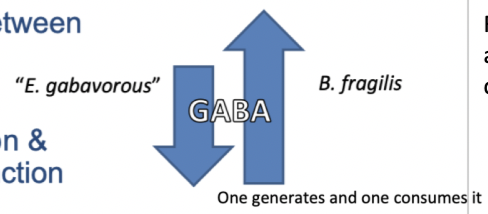
9
New cards
Planetary tera-forming
The world was highly reduced, basically no oxygen
No SO4, NO3, PO4, Fe3+ or bio essential metals
CU,S bound up in non-reactive metals
* Methanogenesis, fermentation
Photosynthesis: includes O2
Terminal electron acceptor available
Wider variety of metabolites/reactions available
Metals released
10
New cards
Viruses, viroid's and prions
Near life e.g. viruses and viroid's, undergo replication but they cant grow and don’t have a metabolism or maintain homeostasis
Prions- proteins that can undergo replication, undergo evolution via natural selection
Prions- proteins that can undergo replication, undergo evolution via natural selection
11
New cards
a micro-organism needs to
\
* Organisms maintain homeostasis
* composed of cells
* undergo metabolism,
* adapt to their environment e.g. swimming towards food
* respond to stimuli e.g. express a particular protein,
* undergo evolution and reproduce
12
New cards
Archaea
* Have ether-linked lipids, mostly antibiotic resistant, extreme conditions
* Similar to bacteria, shape, size, multiply by binary fission, may have flagella, no nucleus or organelles, circular chromosomes
* Similar to eukaryotes as they have no peptidoglycan in cell wall, not troubled by antibiotics
* Bacteria cell walls have peptidoglycan but archea dont
* Similar to bacteria, shape, size, multiply by binary fission, may have flagella, no nucleus or organelles, circular chromosomes
* Similar to eukaryotes as they have no peptidoglycan in cell wall, not troubled by antibiotics
* Bacteria cell walls have peptidoglycan but archea dont
13
New cards
Gram stain=
classify bacteria by cell wall composition
Gram +ve bacteria= simpler walls with a large amount of peptidoglycan (purple stain)
Gram -ve bacteria= less peptidoglycan and an outer membrane (pink stain)
14
New cards
Process of staining gram +/- bacteria
* Add a chemical compound called crystal violet, gets to peptidoglycan and stains it, goes through the sugars, doesn’t go through to inner membrane
* Use a fixative- iodine, causes a reaction between Crystal violet and cell wall components fixes the Crystal Violet to the cell.
* Then add ethanol and wash the outside of the cells (sugars and the lipid membrane) Peptidoglycan remains
* Gram -ve = transparent, so need to add safranin, so they look pink
* Gram positive= purple (still appears purple as a strong stain)
15
New cards
saturated and non-saturated fats
Saturated with hydrogen
Unsaturated= double bond
High temp environments- organism will have more saturated fatty acids
16
New cards
Antibiotics target peptidoglycan
Gram -ve more resistant as it has less peptidoglycan
Some bacteria/archaea have a outer capsule of polysaccharide
Some bacteria/archaea have a outer capsule of polysaccharide
17
New cards
Prokaryotes lack complex compartmentalization
Don’t have ER, golgi apparatus
They have infoldings of the plasma membrane - increase SA for a greater metabolism
They have infoldings of the plasma membrane - increase SA for a greater metabolism
18
New cards
Naming
Genus name is italicized and capitalized
Species epithet e.g. *coli* needs to be italicized but not capitalized
Binomial name
*Escherichia coli*
Then goes to *E. coli*
The names are often meaningful
Species epithet e.g. *coli* needs to be italicized but not capitalized
Binomial name
*Escherichia coli*
Then goes to *E. coli*
The names are often meaningful
19
New cards
classification
Kingdom (domain)
Phylum
Class
Order
Family
Genus
Species
20
New cards
single vs plural
Bacterium vs bacteria
Archaeum vs archaea
Fungus vs fungi
Genus vs genera
21
New cards
Binary fission
1 cell splitting into 2
It is still growth as they don’t increase in biomass but they grow due to their being clones of themselves
Growth can also be increasing the volume of the cell
22
New cards
carbon sources
energy sources
electron sources
energy sources
electron sources
Auto- CO2
Hetero- organic molecules
Photo- light
Chemo- oxidation of inorganic compounds
Litho= inorganic
Organo = organic
Hetero- organic molecules
Photo- light
Chemo- oxidation of inorganic compounds
Litho= inorganic
Organo = organic
23
New cards
Bacterial growth
= 2^n / 2^g (g= generations (n)
Lot of biomass very quickly
Lot of biomass very quickly
24
New cards
Doubling time
1/td
units = hr^-1
units = hr^-1
25
New cards
Batch growth (culture)
Enclosed- contained, limited by volume(space)
Set amount of nutrients
Set amount of nutrients
26
New cards

bacterial growth phases
lag phase: slow growth, getting used to the conditions, modifying metabolism
Exponential phase: maximum growth rate as not limited by anything e.g. space, nutrients
stationary phase: growth is starting to be inhibited and rate is slowing down. Not net change in microbial growth
decline phase: Growth rate < cell death, substrate limited, secondary metabolite build up (Some will generate antibiotics)
Exponential phase: maximum growth rate as not limited by anything e.g. space, nutrients
stationary phase: growth is starting to be inhibited and rate is slowing down. Not net change in microbial growth
decline phase: Growth rate < cell death, substrate limited, secondary metabolite build up (Some will generate antibiotics)
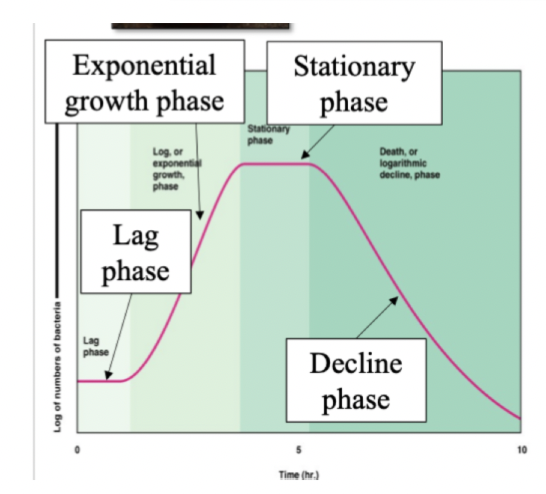
27
New cards

Diauxie
This is due to: Multiple substrates
* Pick what they are going to use first, to ramp up its metabolism to deal with a particular substrate
* Picks substrate it gets the most energy out of, so it can outcompete other cells for the energy
* 2nd substrate, cant grow as fast
2nd lag phase, as the presence of the 1st resource is actively repressing the expression of enzymes involved in the metabolism of the 2nd one = Catabolite repression
* Pick what they are going to use first, to ramp up its metabolism to deal with a particular substrate
* Picks substrate it gets the most energy out of, so it can outcompete other cells for the energy
* 2nd substrate, cant grow as fast
2nd lag phase, as the presence of the 1st resource is actively repressing the expression of enzymes involved in the metabolism of the 2nd one = Catabolite repression
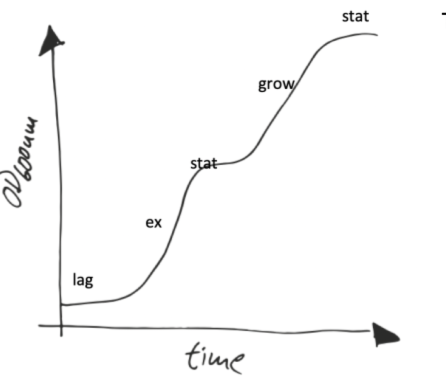
28
New cards
Requirements from microbial growth
Energy
* Predominately light
* Chemical energy
Carbon
* CO2
* Organic compounds, CH4
Liquid water, N,P, S, Na and other elements, Temperature, Space, pH, nutrients, Oxygen conc, Water activity
* Predominately light
* Chemical energy
Carbon
* CO2
* Organic compounds, CH4
Liquid water, N,P, S, Na and other elements, Temperature, Space, pH, nutrients, Oxygen conc, Water activity
29
New cards
Enzyme denaturation
\
* pH, temp, solubility, chemicals
Becomes linear and unfolds
Can return back to normal protein (only some)
30
New cards
Water activity and salinity
Water activity= ability to loose water (evapourates out)
High water activity= loose a lot of water and something that has a low water activity that will pick that water up
High water activity= loose a lot of water and something that has a low water activity that will pick that water up
31
New cards
jam preservation
Jam has v low water activity, the microorganism will desiccate the microorganisms
32
New cards
salt conc.
Water leaves organism to balance out salt conc
Salt can impact how well a micro-organism will grow
\
Pink lake= hyperhalophilic archaea = love salt
Maintain salt balance in high salt conc lakes
Salt can impact how well a micro-organism will grow
\
Pink lake= hyperhalophilic archaea = love salt
Maintain salt balance in high salt conc lakes
33
New cards
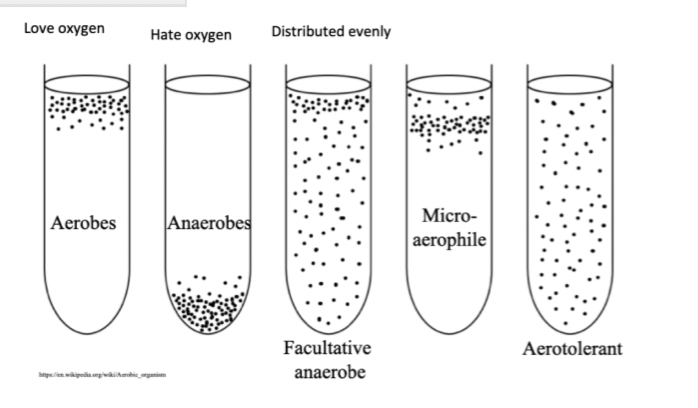
oxygen
Oxygen is toxic to some micro-organisms
Making superoxide's, peroxides that can break the cell walls
uses superoxide dismutase to convert oxide to o2g
Making superoxide's, peroxides that can break the cell walls
uses superoxide dismutase to convert oxide to o2g
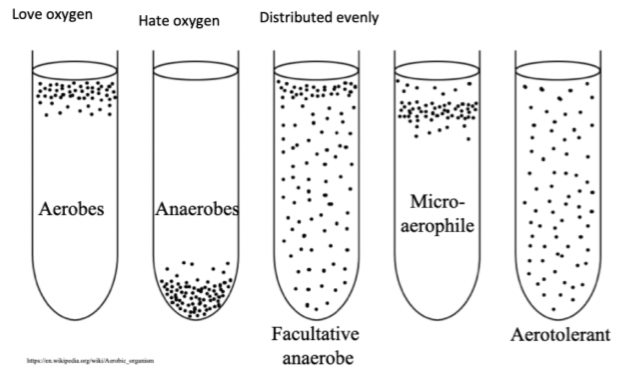
34
New cards
Why do micro-organisms need controlling
Food-spoilage
20% of spoiled food post-harvest
Prevent disease
* Food borne disease
* Campylobacteriosis -> campylobacter (common in chicken guts)
* Nosocomial (hospital-acquired) infections
* Control micro-organism in hospitals can prevent secondary infections
* Pneumonia -> Acinetobacter sp.
Prevent industrial and experimental contamination
* Industrial settings
* Bioreactors
* Alexander Flemming - eating orange in lab and noticed he got penicillin growing on the orange peel and noticed there was bacterial inhibition= discovery of antibiotics
20% of spoiled food post-harvest
Prevent disease
* Food borne disease
* Campylobacteriosis -> campylobacter (common in chicken guts)
* Nosocomial (hospital-acquired) infections
* Control micro-organism in hospitals can prevent secondary infections
* Pneumonia -> Acinetobacter sp.
Prevent industrial and experimental contamination
* Industrial settings
* Bioreactors
* Alexander Flemming - eating orange in lab and noticed he got penicillin growing on the orange peel and noticed there was bacterial inhibition= discovery of antibiotics
35
New cards
Disinfection
**Disinfection**: destruction or removal of viable vegetative cells, they are growing
* Not bacterial endospores
36
New cards
**Sterilization**:
**Sterilization**: complete destruction of viable vegetative cells and bacterial endospores
37
New cards
Antisepsis:
**Antisepsis:** chemicals applied to bodily surfaced to destroy or inhibit vegetative pathogens
* Can be bactericidal or bacteriostatic
* Topical disinfection e.g. spraying a surface with ethanol or adding Dettol to a cut
38
New cards
Chemotherapy:
**Chemotherapy:** chemicals used internally to kill or inhibit growth of cells within host tissues
39
New cards
Sanitization:
**Sanitization:** microbial populations reduced to levels to be considered safe
* Reducing the number of microbial populations
* E.g. milk produce a production that will have micro-organisms but sanitized to a level that will the product will be safe over the time you are likely to use it
* Treat it so pathogens aren't there
40
New cards
**Microbial death**:
the loss of membrane integrity and loss of electrical potential across the membrane
41
New cards
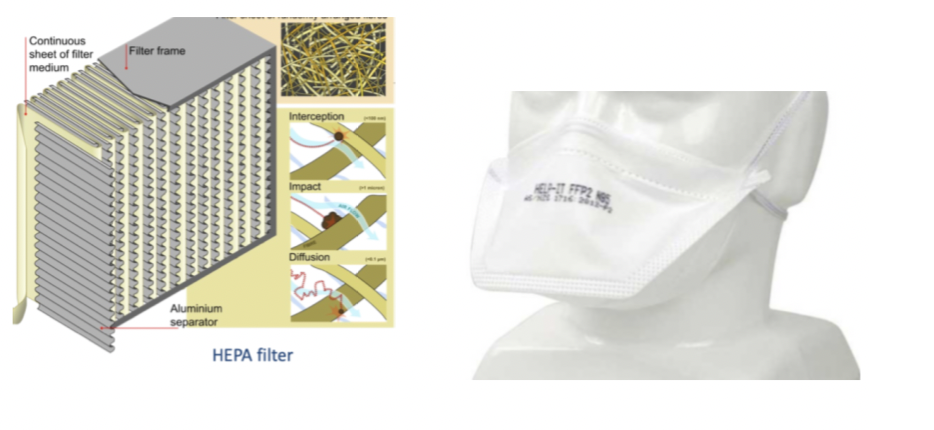
**Mechanical removal (filtration)** sterilization
\
**Depth filters**: bonded fibrous or granular material (asbestos, diatomaceous earth(diatom shell))
larger gaps between where microorganisms can move but will eventually be intercepted over time and absorbed diatomaceous earth.
Replies on electrostatic attraction and diffusion, interception of particles as they move through the filter
Good for large volumes air and gas
Not good for liquids, liquids will move through and wont be intercepted
larger gaps between where microorganisms can move but will eventually be intercepted over time and absorbed diatomaceous earth.
Replies on electrostatic attraction and diffusion, interception of particles as they move through the filter
Good for large volumes air and gas
Not good for liquids, liquids will move through and wont be intercepted

42
New cards
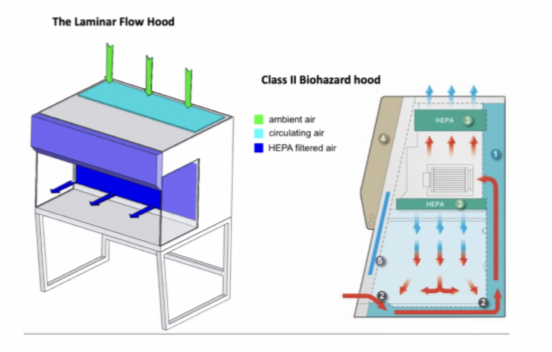
**Mechanical removal (filtration)Laminar flow hood-**
Laminar flow hood-
Air comes in through the top through the big filter and blows clean air through
Environment where there is no micro-organisms.
HEPA filter= \[physical way of filtering micro-organisms from the air
Air comes in through the top through the big filter and blows clean air through
Environment where there is no micro-organisms.
HEPA filter= \[physical way of filtering micro-organisms from the air
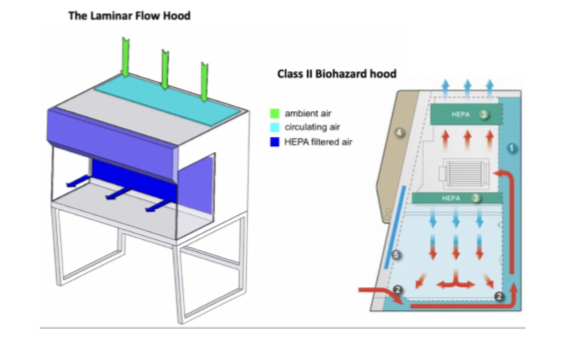
43
New cards
Membrane filter (mechanical filter)
Membrane filter
* Very thin layer of material that has small holes in it, used for liquid with microorganisms, microorganisms trapped on one side and the liquid on others (0.1mm for cellulose acetate, 0.2 um for bacteria cells)
* Can vary in pore size depending on the micro-organism
Post-grad accidentally used too small of a filter and found micro-organisms that were extremely small, new phylum of bacteria
44
New cards
**Physical control methods**
Temperature
* Increase temp beyond the t op tmax get cell lysing and not being able to grow, too high all the cells will die
* Increase temp beyond the t op tmax get cell lysing and not being able to grow, too high all the cells will die
45
New cards

Moisture based temp by using an autoclave
**Moisture based temp by using an autoclave**
* Water in there, then crank handle up to increase pressure and get to 121 deg c and 15psi,. Will kill all organisms both vegetative and spores
All at different temps
Yeasts in vegetative state, 5min and 60 deg they will die
\
Ensure all are killed at 15 psi and 121 C but not extremeophiles
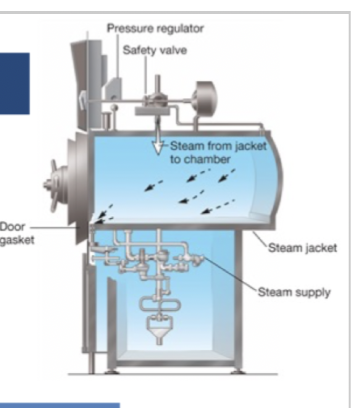
46
New cards
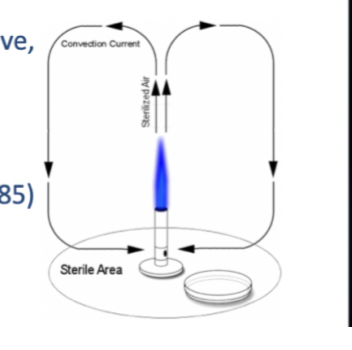
physical method, dry heat e.g. oven
160 deg C for 2 hrs- has to be for 2hrs as heat transfer is less efficient as it is drier heat is transferred a lot better through water
Moist heat kills micro-organisms quicker
Use Bunsen burner, way above 60deg
Moist heat kills micro-organisms quicker
Use Bunsen burner, way above 60deg
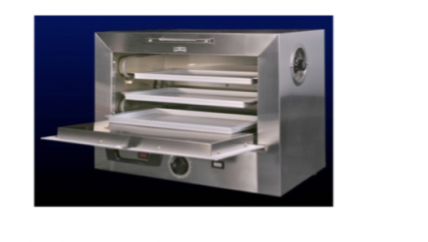
47
New cards
Pasteurization ( disinfection and sanitization)
* Heat it to about 60deg and will kill 99.99% of the pathogens/micro-organisms
* Going it enough so that it can have a longer shelf life e.g. UHT milk
* Going it enough so that it can have a longer shelf life e.g. UHT milk
48
New cards
Boiling liquids (disinfection and sanitization)
* Will only kill vegetative cells (not spores)
* Microorganisms need to be at a certain conc. Or grow in certain conditions for you to get sick
* Microorganisms need to be at a certain conc. Or grow in certain conditions for you to get sick
49
New cards
**Ionizing** radiation (physical control)
Sterilization technique
* Damages DNA, lipids, proteins ( electrons, OH- radicals, H radicals
* Indiscriminate and moves through the system well
* Can kill you very quickly
* Radiation measured in grays, lethal dose for humans = 5 Gy
* Damages DNA, lipids, proteins ( electrons, OH- radicals, H radicals
* Indiscriminate and moves through the system well
* Can kill you very quickly
* Radiation measured in grays, lethal dose for humans = 5 Gy
50
New cards
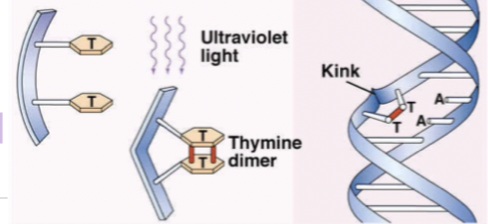
**Non-ionizing** radiation (physical control)
UV treatment = disinfection
220-300nm
UV light changes the DNA structure, get complexes between adjacent nucleotide
Get Thymine dimer, binding together on DNA strand causing a kink, which means that the polymerase cant go along and read that dna as there is a kink
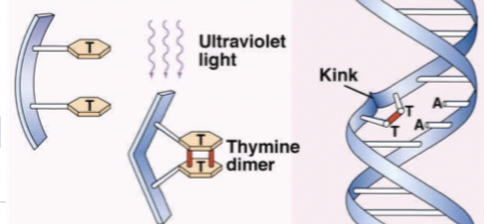
51
New cards
chemical control methods
Chemical agents via gases or liquids
e.g.
liquids
Phenols and alcohols- which denature proteins and dissolve membrane lipids (alcohols such as ethanol will sanitise)
Halogens- oxidation of cellular material
Aldehydes- inactivates nucleic acids and proteins
Gases e.g. Ethylene oxide which are very toxic
e.g.
liquids
Phenols and alcohols- which denature proteins and dissolve membrane lipids (alcohols such as ethanol will sanitise)
Halogens- oxidation of cellular material
Aldehydes- inactivates nucleic acids and proteins
Gases e.g. Ethylene oxide which are very toxic
52
New cards
toothpaste and Triclosan
Most toothpaste/ personal care products will have Triclosan which is Anti-microbial, issue as micro-organisms can help break down micro-organisms, also going into waterways, brings about anti-microbial resistance
Inhibits enzymes used in fatty acid synthesis
53
New cards
Antibiotics, antimicrobial agents produced by micro-organisms
Variety of modes of action
Some impact peptidoglycan, ribosomes, lipid photosyntheise
Micro organism generate these to beat other microorganisms and compete with them
Then they have methods to deal with antibiotics/microbial
Some impact peptidoglycan, ribosomes, lipid photosyntheise
Micro organism generate these to beat other microorganisms and compete with them
Then they have methods to deal with antibiotics/microbial
54
New cards
Anti-antibiotics
Generate pumps to pump out antibiotics fast
Compounds that will absorb the antibiotics in order to render them useless
Issue as the antibiotic resistance mechanism are sitting on plasmids and get transferred left and right to other micro-organisms
Need to finish the course of your antibiotics as you might start selecting for micro-organisms with antibiotic avoiding capabilities.
55
New cards
**Biological control methods**
Viruses are used to control micro-organisms involved in food spoilage/food related illness
E.g. in cheese use phages that specifically tackle infections
Predator and viruses= antisepsisToxin= sterilization
*Bdellovibrio*= bacterial parasite (bdello= leech)
Feeds on biopolymers( proteins and nucleic acids) of their host. They are unable to replicate outside of the hosts cell
E.g. in cheese use phages that specifically tackle infections
Predator and viruses= antisepsisToxin= sterilization
*Bdellovibrio*= bacterial parasite (bdello= leech)
Feeds on biopolymers( proteins and nucleic acids) of their host. They are unable to replicate outside of the hosts cell
56
New cards
**Metabolism**
**s**um total of anabolic reaction and catabolic reaction
57
New cards
anabolism and catabolism
**Anabolism**: reaction that is taking something that is simple and generate something more complex, needs energy
**Catabolism**: Reaction that involves breaking down complex molecules to use the energy released for work
**Catabolism**: Reaction that involves breaking down complex molecules to use the energy released for work
58
New cards
micro-organisms and energy usage
Micro-organisms take advantage of the 1st and 2nd laws of thermodynamics (Taking energy and converting it to something useful)
Micro-organisms are bags full of catalysts that efficiently harvest energy for growth and maintenance
Micro-organisms are bags full of catalysts that efficiently harvest energy for growth and maintenance
59
New cards
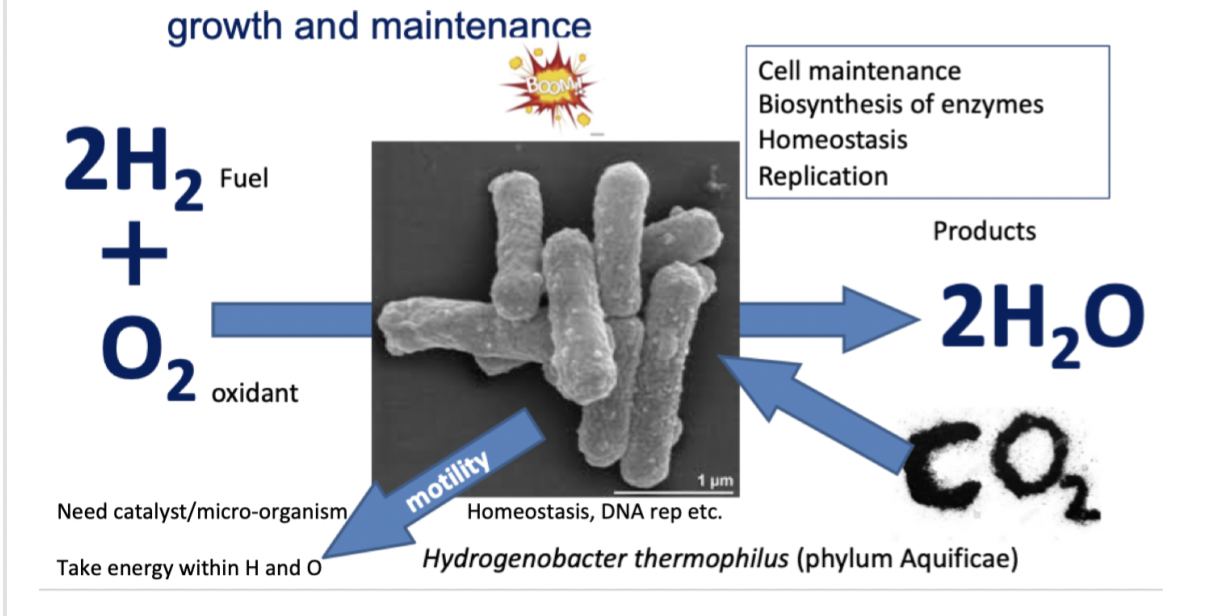
how bacteria gets energy
Bacteria isnt getting any C from the substrates so uses some energy made to absorb CO2 as it needs carbon to grow.
Cells cant use heat energy to drive work
Cells cant capture and use all the energy from oxidation reactions at once
Cells cant use heat energy to drive work
Cells cant capture and use all the energy from oxidation reactions at once
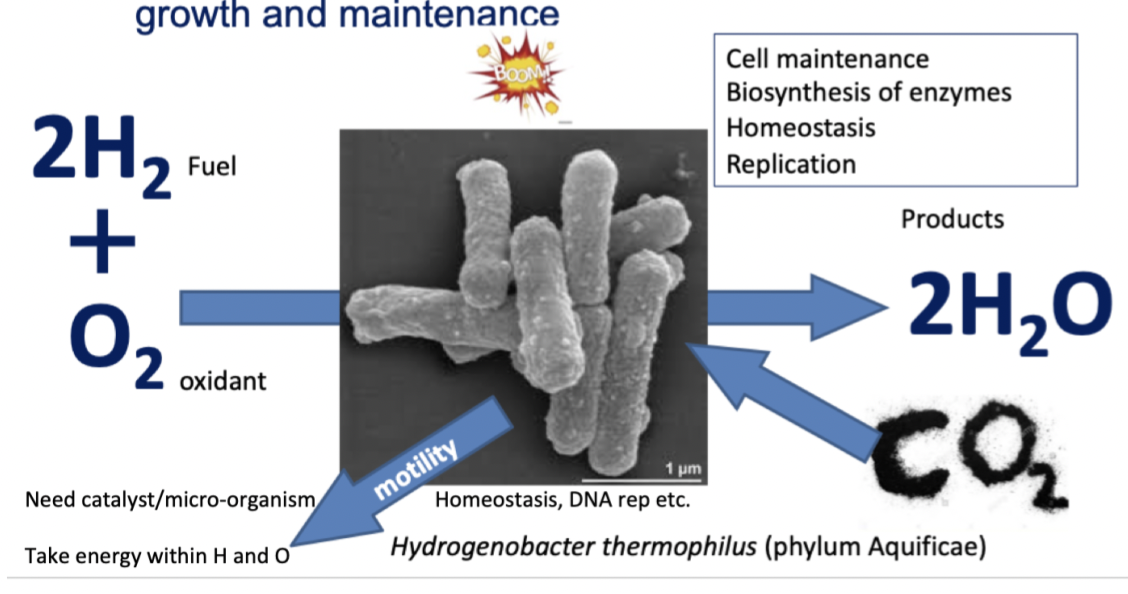
60
New cards
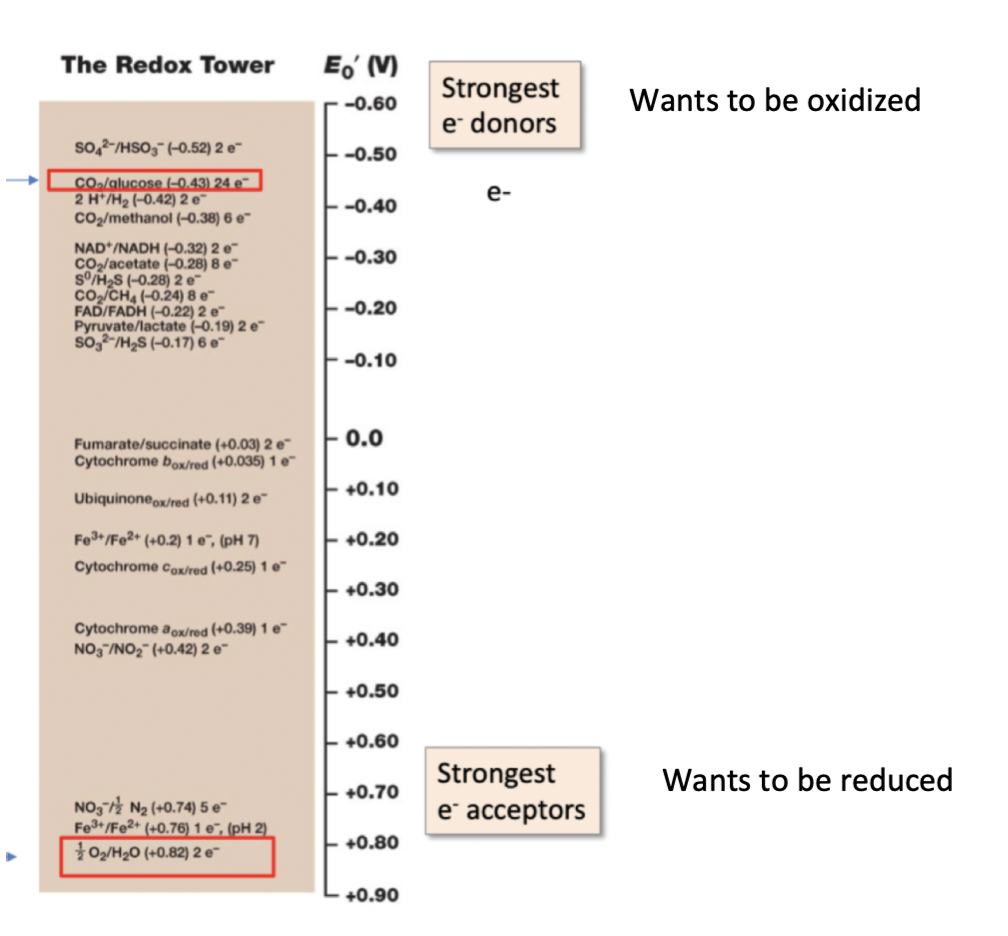
**Redox reactions**
Reactions where electrons are moved from a donor to an acceptor of electrons
\
\
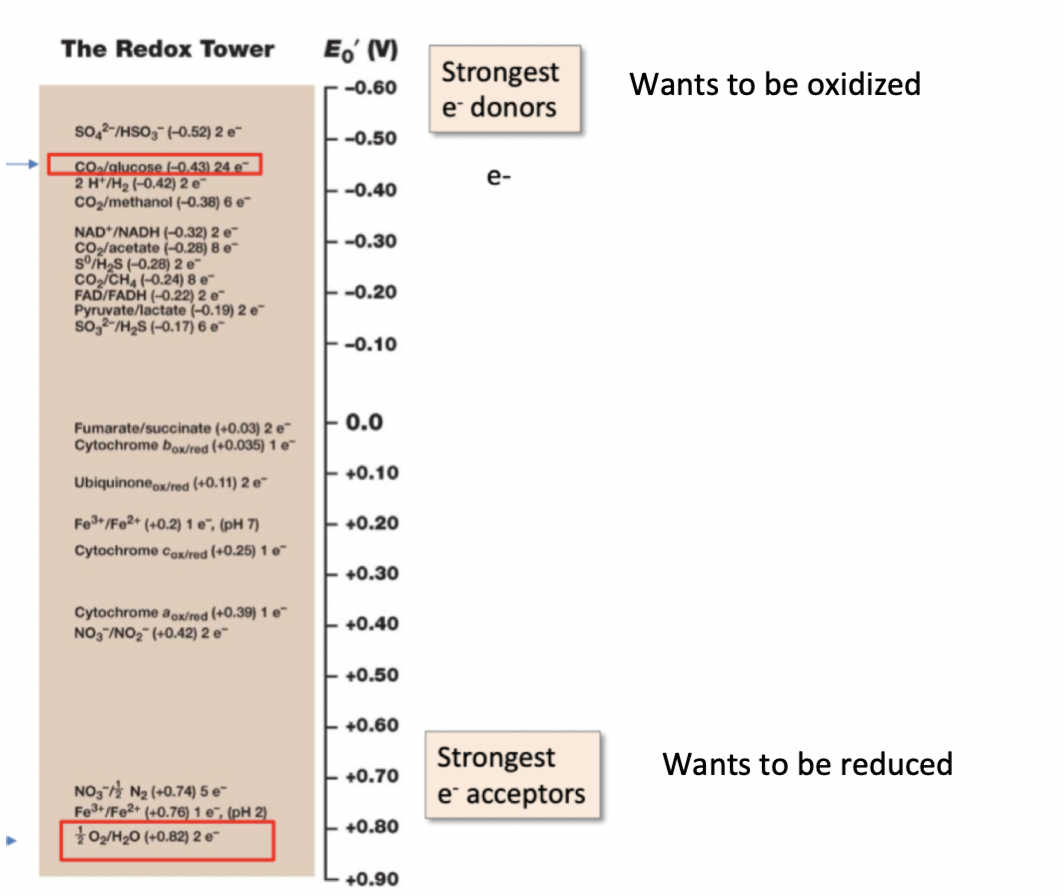
61
New cards
**Standard reduction potential (E0')**:
measure of the tendency of the donor of a half reaction to lose electrons
* The more -ve the E0', value the more likely the donor will donate an electrons
delta**E0' = E0 acceptor pair - E0 donor pair**
* The more -ve the E0', value the more likely the donor will donate an electrons
delta**E0' = E0 acceptor pair - E0 donor pair**
62
New cards

Not every reduction reaction is for energy generation (Dissimilative and **Assimilative reduction**)
**Dissimilative reduction**: reductive reactions of electron acceptors used for energy generation
**Assimilative reduction**: reductive reactions of electron acceptors used to acquire essential components ( C,N,S) for the synthesis of biomolecules
**Assimilative reduction**: reductive reactions of electron acceptors used to acquire essential components ( C,N,S) for the synthesis of biomolecules

63
New cards
losing electrons in redox reactions.
**Electron is high energy and is going to low energy as it moves through the system**
During redox reaction
Every time it goes through a complex/system it decreases in energy
\
During redox reaction
Every time it goes through a complex/system it decreases in energy
\
64
New cards

doesn’t go from A to B in one reaction as they cant capture and use all the energy from oxidation reactions at once
Does steps down the redox tower in little bursts
* Donates to a NADH small amount of energy to pump the proton out
* Then goes through the quinone system
* Then transferred to cytochrome bc complex
* Transported to cytochrome C
* Donates to a NADH small amount of energy to pump the proton out
* Then goes through the quinone system
* Then transferred to cytochrome bc complex
* Transported to cytochrome C

65
New cards

Enzymes
Enzymes are the catalysts of the biological world
Allow you to go past the activation energy as they reduce the energy activation requirement
Allow you to go past the activation energy as they reduce the energy activation requirement

66
New cards
Exergonic/endergonic reactions
**Exergonic reaction:** reaction where energy is released and the reaction is considered spontaneous
**Endergonic reaction:** reaction that requires energy input to be driven and is considered non-spontaneous
**Endergonic reaction:** reaction that requires energy input to be driven and is considered non-spontaneous
67
New cards

free energy change
**Free energy change:** the amount of energy available to do useful work ( Delta G0) for microbes
If the free energy is -ve (energy of products smaller than substrates) = exergonic
If the free energy is +ve(energy of products is greater than substrates)= endergonic
If the free energy is -ve (energy of products smaller than substrates) = exergonic
If the free energy is +ve(energy of products is greater than substrates)= endergonic

68
New cards

free energy availability
If there is free energy available, there is enough energy to give you a -ve change in -deltaG0, then a micro-organism has found a way to use it and then grow

69
New cards
Energy conservation
A microbe aims to convert external energy sources as efficiently as possible to biomolecules (anabolism) or easily usable internal energy sources (catabolism)
Either
* High energy stores (glycogen, PHA's)
* Adenosine triphosphate (ATP)
Either
* High energy stores (glycogen, PHA's)
* Adenosine triphosphate (ATP)
70
New cards
They aim to do this with the minimum amount of energy loss. This energy conservation comes in the form of
1. Oxidative phosphorylation
* The oxidation of substrates to generate ATP
\
2. Substrate-level phosphorylation
* The removal and direct transfer of PO3- from substrates to ADP (To make ATP)
* Energy released from getting the phosphate off generates ATP
\
3. Electron bifurcation
* Coupling exergonic and endergonic electron transfer reaction to limit energy loss
* Simultaneously at the same time ender and exergonic
71
New cards
ATP and the energy currency of cells
* ATP is a cells energy storage system
* ATP is used to drive cellular endergonic reactions (anabolism)
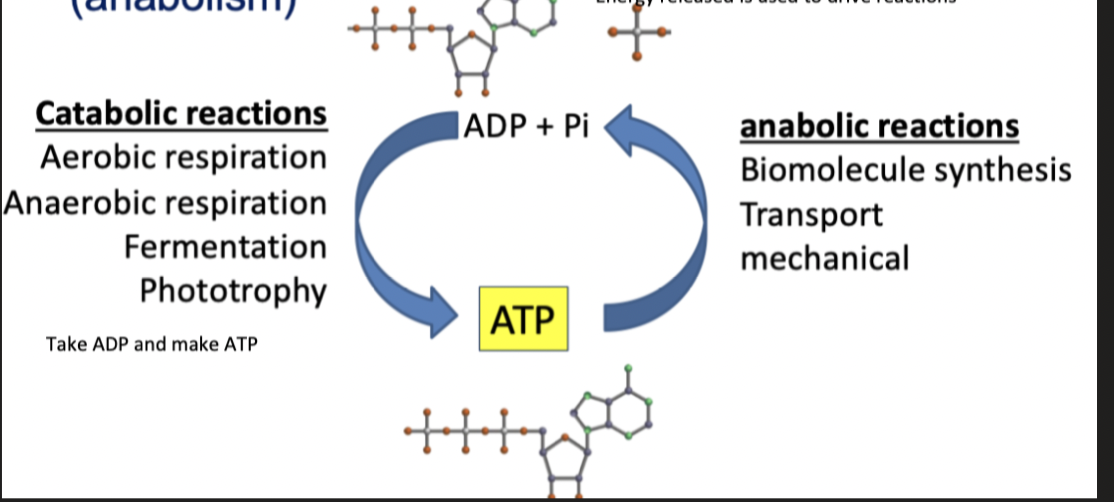
72
New cards
How is the energy stored/used
* Free energy from catabolic reactions is used to generate ATP
* ATP is used to drive endergonic processes
73
New cards
How are electrons transferred between oxidants and reductants to allow for maximal energy conservation?
They use electron carriers( co-enzymes)
Accept energetic electrons move them to where they are needed then release them
Electron carriers
* Cells generate coenzymes that accept/donate electrons in reaction
* They carry electrons from one reaction center to the next
* The each have a different standard redox potentials.
e.g. Nicotinamide adenine dinucleotide phosphate \n (NADP+/NADPH -320 mV) \[same as NAD+/NADH\]
Accept energetic electrons move them to where they are needed then release them
Electron carriers
* Cells generate coenzymes that accept/donate electrons in reaction
* They carry electrons from one reaction center to the next
* The each have a different standard redox potentials.
e.g. Nicotinamide adenine dinucleotide phosphate \n (NADP+/NADPH -320 mV) \[same as NAD+/NADH\]
74
New cards
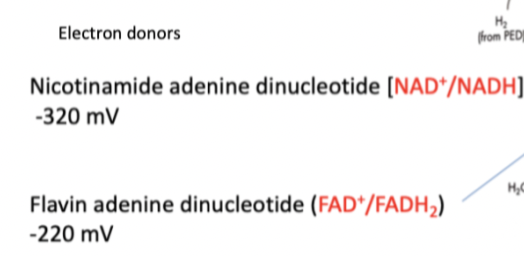
Each coenzyme
* Accepts electrons from more redox -ve donors and donates electrons to more redox positive acceptors
* Microbes maximize their ability to conserve energy derived from oxidation reduction reactions

75
New cards
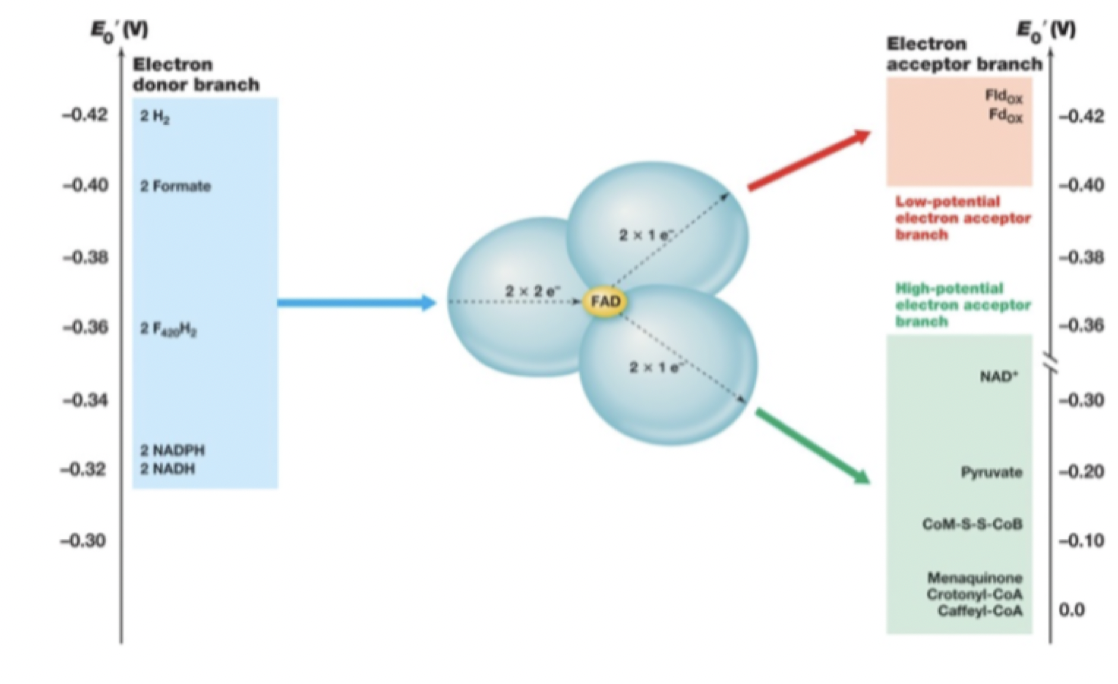
Electron bifurcation
Putting electrons down here to less energetic states, but there is still excess energy which is used to boost the other electrons to a more energetic state, used for more complex processes/ processes that require more energy
Cells requiring more electronegative source an turbo-charge electrons for difficult/energetically demanding reactions can use electron bifurcation.
Cells requiring more electronegative source an turbo-charge electrons for difficult/energetically demanding reactions can use electron bifurcation.
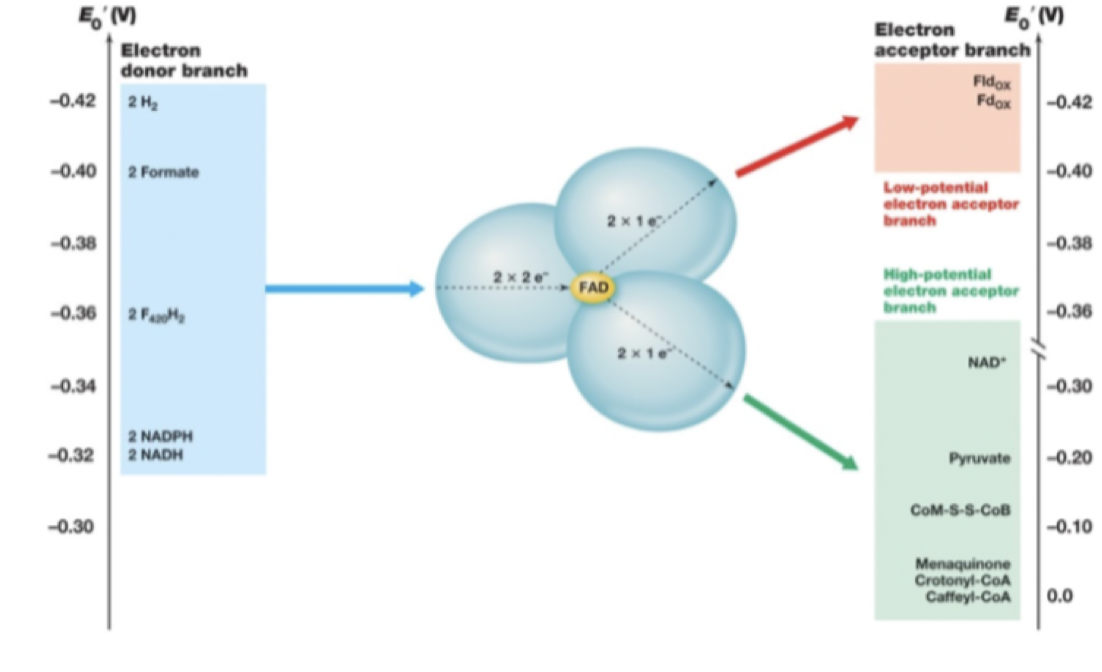
76
New cards
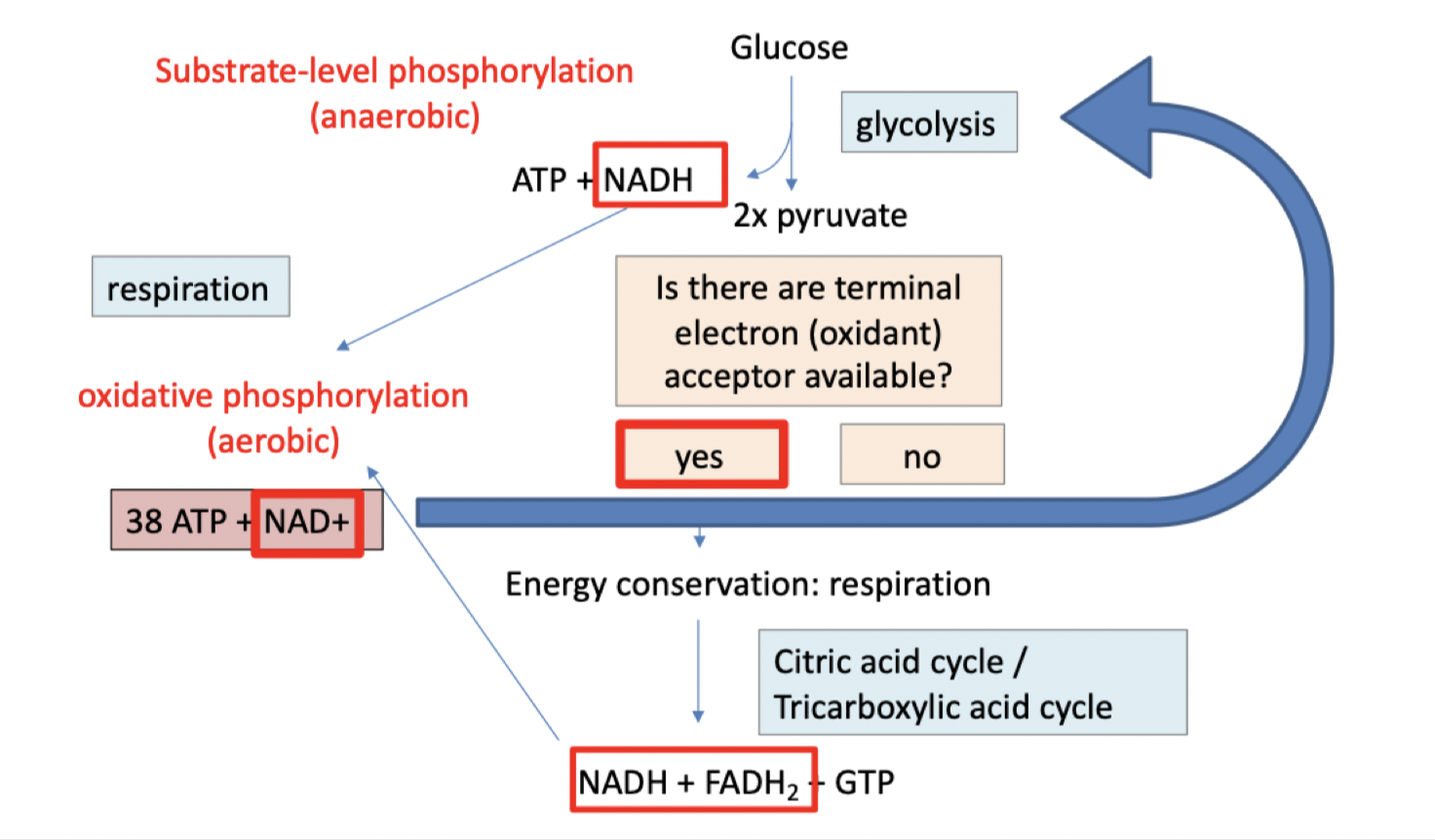
**Glycolysis**
Refers to all pathways used to break down glucose to a pyruvate.
* Uses substrate level phosphorylation- when adding on a phosphate then pulling it off again to generate ATP
* Anoxic- doesn’t need oxygen, or a terminal electron acceptor
* Takes glucose and makes a pyruvate
* Final products = Oxidized = multiple ATP, NADH, and 2 pyruvate
* Uses substrate level phosphorylation- when adding on a phosphate then pulling it off again to generate ATP
* Anoxic- doesn’t need oxygen, or a terminal electron acceptor
* Takes glucose and makes a pyruvate
* Final products = Oxidized = multiple ATP, NADH, and 2 pyruvate
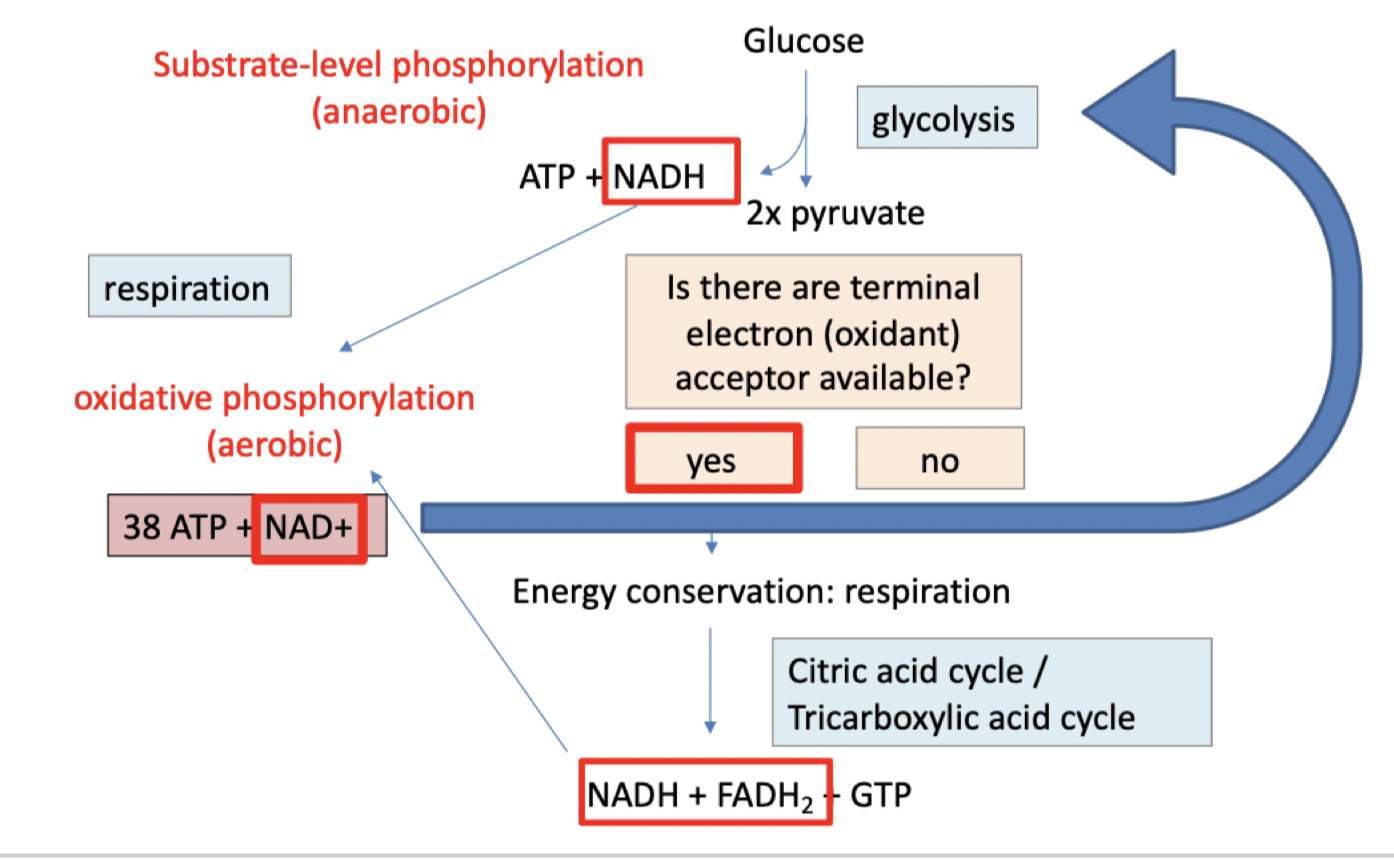
77
New cards
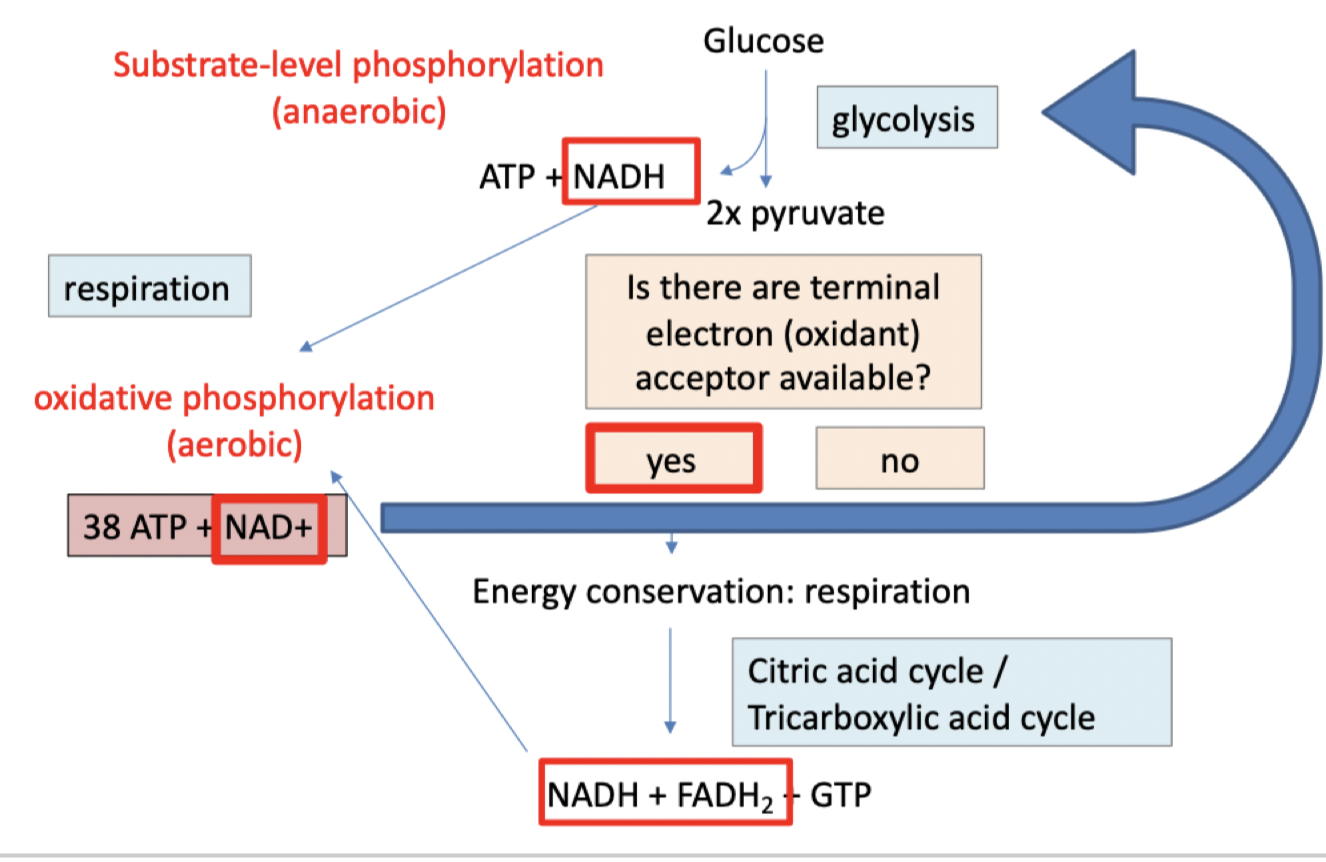
ASKS THIS QUESTION Does it have a terminal electron acceptor (something to accept the electron via the consumption of glucose) ?
Yes= TCA and respiration
No= fermentation (anerobic respiration)
\
Yes, then goes to the CAC and ETC
No= fermentation (anerobic respiration)
\
Yes, then goes to the CAC and ETC
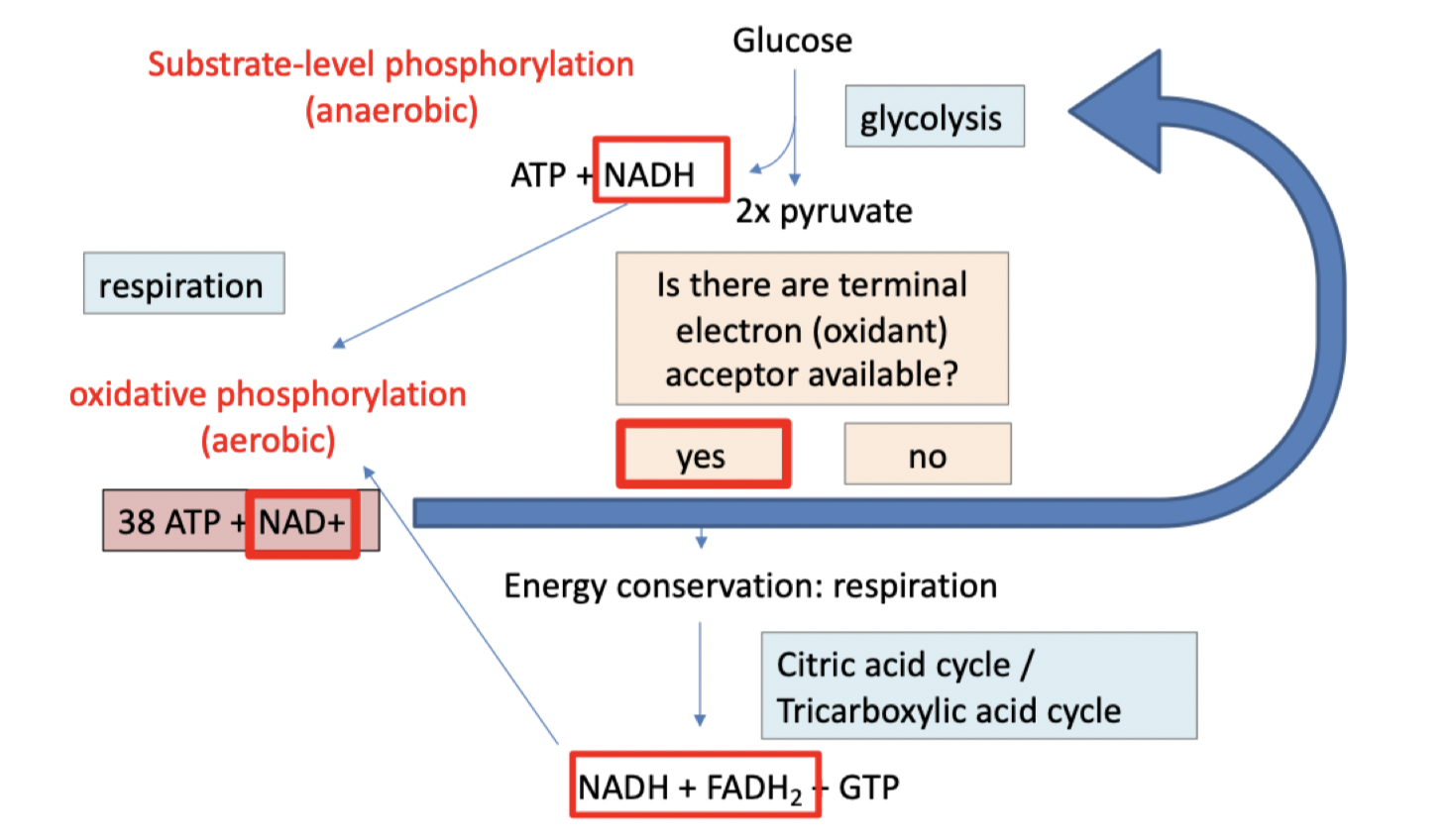
78
New cards

**Citric acid cycle**
Pyruvate coming in and generate another NADH, carbons are donated, as being oxidized it is generating energized electron carriers and ATP (anabolic reactions to make compounds)m = pyruvate oxidation
Products
3 CO2
4 NADH
FADH2
GTP (ATP)
Products
3 CO2
4 NADH
FADH2
GTP (ATP)

79
New cards

**Oxidative phosphorylation**
As electrons are being passed, on the energy lost out , pumps protons out which helps form the proton gradient
Transfer electrons from NADH and FADH2 through the membrane protein complexes and ultimately to oxygen where they combine to form water. As electrons travel through the protein complexes in the chain, a gradient of hydrogen ions (protons) forms across the cytoplasmic membrane
Cells harness the energy of this proton gradient tot create 3 additional ATP molecules for every electron that travels across the chain
Transfer electrons from NADH and FADH2 through the membrane protein complexes and ultimately to oxygen where they combine to form water. As electrons travel through the protein complexes in the chain, a gradient of hydrogen ions (protons) forms across the cytoplasmic membrane
Cells harness the energy of this proton gradient tot create 3 additional ATP molecules for every electron that travels across the chain
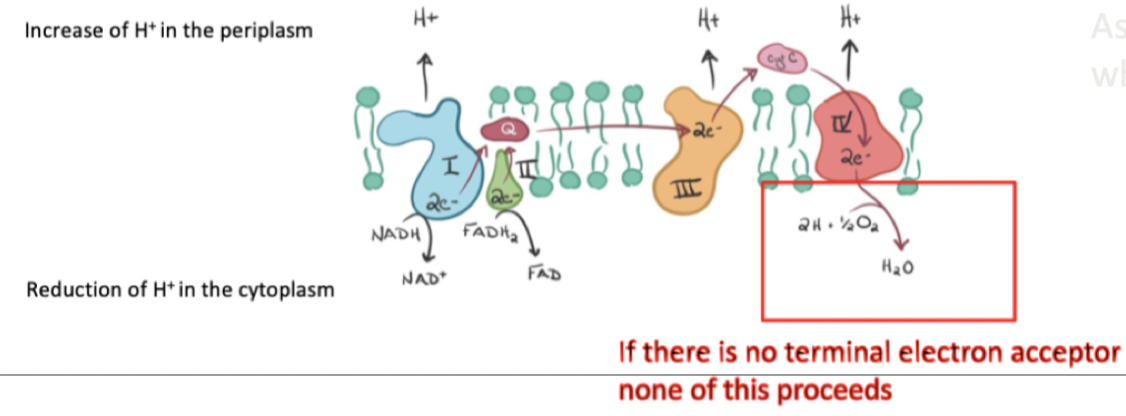
80
New cards
**Fermentation ( no terminal electron acceptor)**
Substrate level phosphorylation, to produce ATP
Need to generate more NAD+ which fermentation does
Ferments pyruvate
Generates 2 ATP
Needs to generate NAD+, (pyruvate is reduced by NADH)
**Products** lactic acid, Yeast ferments to alcohol, butanol, propanoic acid, H2
Need to generate more NAD+ which fermentation does
Ferments pyruvate
Generates 2 ATP
Needs to generate NAD+, (pyruvate is reduced by NADH)
**Products** lactic acid, Yeast ferments to alcohol, butanol, propanoic acid, H2
81
New cards
Cavities form due to fermentation
\
Thick layer of plaque, no oxygen getting into the bottom, so generate lactic acid/organic acids, which goes into our teeth and form cavities
82
New cards
Not all micro-organisms use:
Glucose can be an energy or carbon source
Oxygen as a terminal electron acceptor
Can use; Sulfate, nitrate as a terminal electron acceptor instead of oxygen
Fixing carbon from carbon dioxide- non-organic
Oxygen as a terminal electron acceptor
Can use; Sulfate, nitrate as a terminal electron acceptor instead of oxygen
Fixing carbon from carbon dioxide- non-organic
83
New cards
Metabolic diversity
Unlimited number of oxidation and reduction pairs
Need + standard redox potential
Have evolved to utilize any free energy to establish a niche
Need + standard redox potential
Have evolved to utilize any free energy to establish a niche
84
New cards
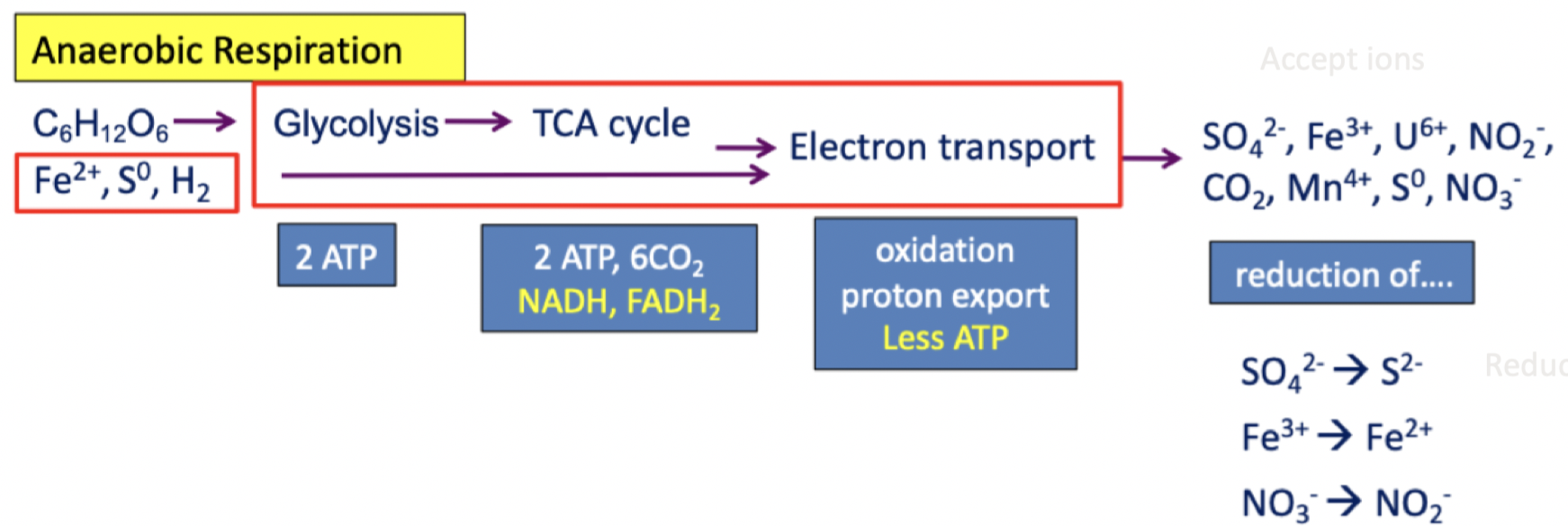
anaerobic respiration
The micro-organisms will find what their next best electron acceptor, closer to bottom of redox tower
\
Reducing SO4 2- -> S2-
Fe3+ -> Fe2+
NO3- -> NO2-
Less energy as the difference in the redox tower isnt as big, so have less energy to pump protons across the gradient and then bring them back
\
Reducing SO4 2- -> S2-
Fe3+ -> Fe2+
NO3- -> NO2-
Less energy as the difference in the redox tower isnt as big, so have less energy to pump protons across the gradient and then bring them back

85
New cards
Methanotrophs
Methane consumption by micro-organisms
\
Methane donates electrons, Oxygen accepts them
deltaG= -ve, lots of energy, Can produce more ATP as making more energy (More energy per mole of methane)
\
Methane donates electrons, Oxygen accepts them
deltaG= -ve, lots of energy, Can produce more ATP as making more energy (More energy per mole of methane)
86
New cards

Anaerobic methane-consuming archaea (ANME)
Mix of methanogenic (driving methanogenesis reaction in reverse) archaea and sulphate-reducing bacteria
Can sill use methane, archaea and bacteria working together
Produces sulfate
DeltaG = -ve, produces a whole lot less energy, all processes run a lot slower
red=Oxidises methane to co2
green=Reduces so4^2- to HS-
Can sill use methane, archaea and bacteria working together
Produces sulfate
DeltaG = -ve, produces a whole lot less energy, all processes run a lot slower
red=Oxidises methane to co2
green=Reduces so4^2- to HS-
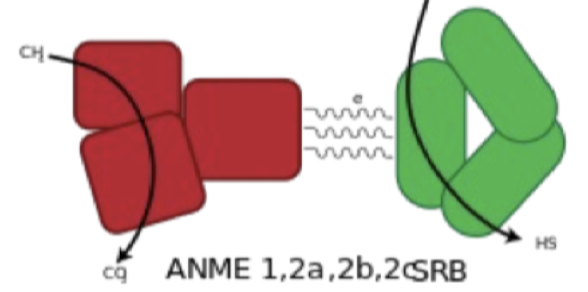
87
New cards
methanogenesis
Only archaea, generates energy from methane
CO2 is reduced by e-s donated from H2
V small amount of energy and produce very little energy with any substate
Metabolism Isn't straight forward, different orders of reactions, different substrates used in different environments/conditions
CO2 is reduced by e-s donated from H2
V small amount of energy and produce very little energy with any substate
Metabolism Isn't straight forward, different orders of reactions, different substrates used in different environments/conditions
88
New cards
Hydrogen powered sulphite reduction
*Desulfovibrio vulgaris*
Hydrogen as an electron donor
Sulphite as electron acceptor
Difference between them = small, so very little amount of energy produced
Hydrogen as an electron donor
Sulphite as electron acceptor
Difference between them = small, so very little amount of energy produced
89
New cards
How does *Desulfovibrio vulgaris* fit into central metabolism
* No glucose in the reaction
* Generates ATP, to fix carbon so it can grow
* Runs in reverse
* Not making co2, it is fixing co2- bringing it into the system
* Then passes it into glycolysis in reverse
* Anabolic, make more complex compounds to make nucleotides and fatty acids
* Generates ATP, to fix carbon so it can grow
* Runs in reverse
* Not making co2, it is fixing co2- bringing it into the system
* Then passes it into glycolysis in reverse
* Anabolic, make more complex compounds to make nucleotides and fatty acids
90
New cards
Other autotrophs
ATP used for C fixation, ATP drives carbon fixation,CO2 made into complex compounds then runs through the system to
Yellow= central to all of live and they can run it in different ways depending on the substrate used
Yellow= central to all of live and they can run it in different ways depending on the substrate used
91
New cards
The fundamentals of central metabolism
energy metabolism, C-fixation remains the same it’s the sources that change
92
New cards
arsenic and methane
Arsenic in drinking water
Which is toxic, being mobilised by micro-organsims and can go into water ways
Increase in temperature causes permafrost to melt which causes methane to be released.
Good for methanotrophs, but if they consume all of it they release CO2 as a byproduct
93
New cards
why is the sulfur, iron and carbon cycles important
Sulphur is important for helping proteins fold
Can cause acid rain and thus the acidification of soils
Iron :Enzyme centers in proteins, haemoglobin
Corrosion, mining, climate change
\
Carbon is needed for life
Photosynthesis, eutrophication, climate change
94
New cards
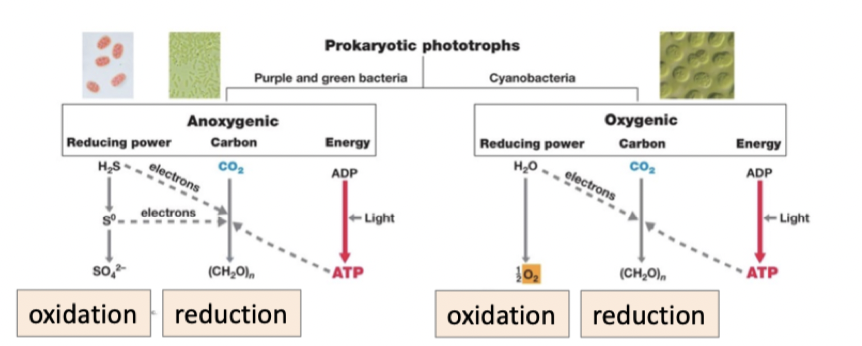
phototrophy
Phototrophy generates lots of compounds we need
Oxygenic phototrophy (cyanobacteria), H2O oxidised to , make oxygen
Anoxygenic phototrophy (purple and green bacteria), other compound oxidised not oxygen e.g. So42- to H2S
Oxygenic phototrophy (cyanobacteria), H2O oxidised to , make oxygen
Anoxygenic phototrophy (purple and green bacteria), other compound oxidised not oxygen e.g. So42- to H2S
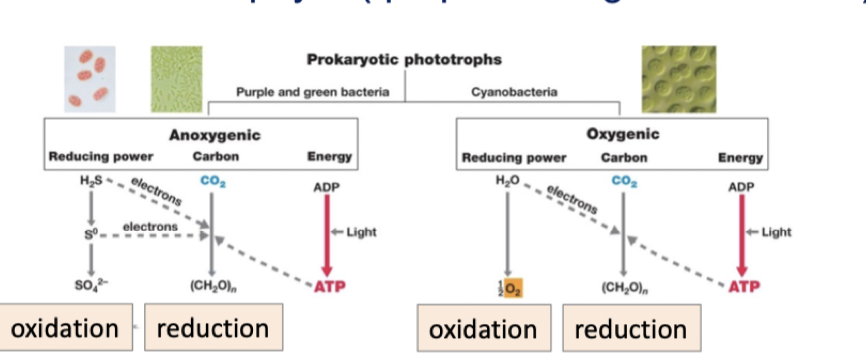
95
New cards
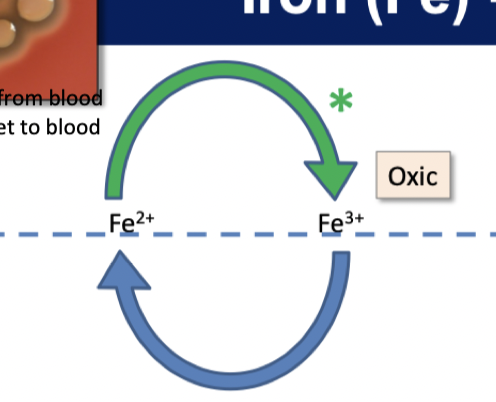
Iron oxic and anoxic
OXIC
* Ferric iron = oxidizing agent
* Get orange colour
* aerobic microorganisms
\
ANOXIC
* Fe3+ to Fe2+
* black colour
* anerobic micro-organisms
* Coupled with H2 or simple organics as energy donors
* Ferric iron = oxidizing agent
* Get orange colour
* aerobic microorganisms
\
ANOXIC
* Fe3+ to Fe2+
* black colour
* anerobic micro-organisms
* Coupled with H2 or simple organics as energy donors
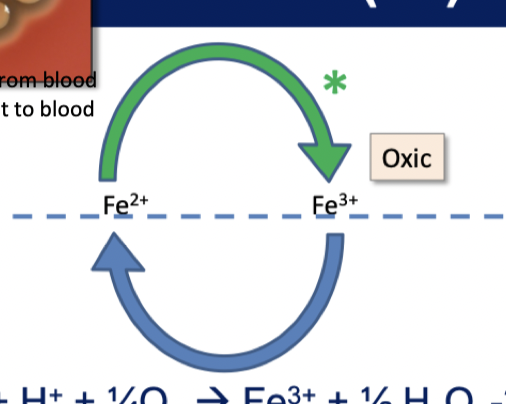
96
New cards
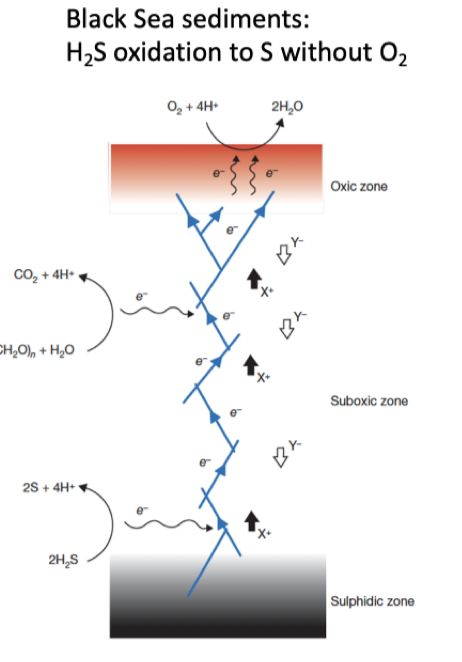
Fe and nanowires
Have nanowires Move electrons from iron rich to iron poor areas through this material
\
Were able to oxidise hydrogen sulfide which requires oxygen in anoxic conditons.
* Via nanowires there was the transfer of oxygen via redox reactions between organisms
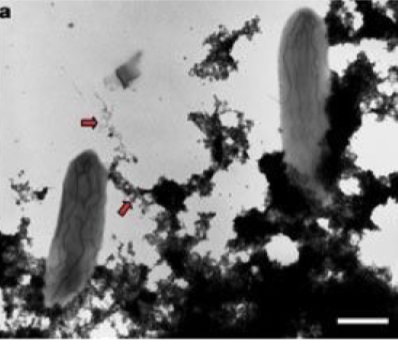
97
New cards
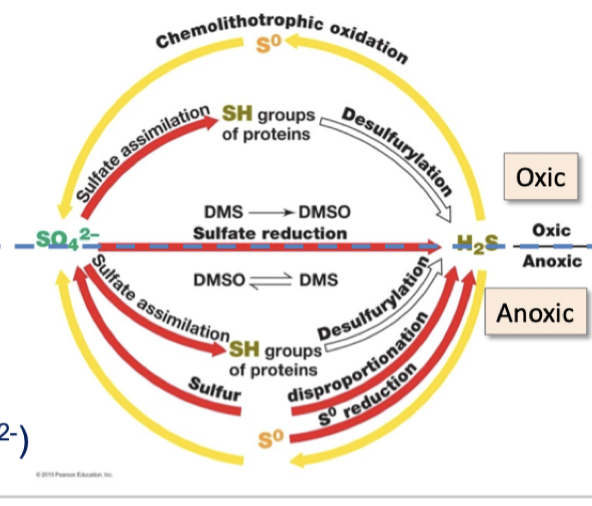
Sulphur oxic and anoxic
oxic
* Elemental sulphur reflect light to get that green-yellow colour
* oxidised
anoxic
* S0 to H2S
* Elemental sulphur reflect light to get that green-yellow colour
* oxidised
anoxic
* S0 to H2S
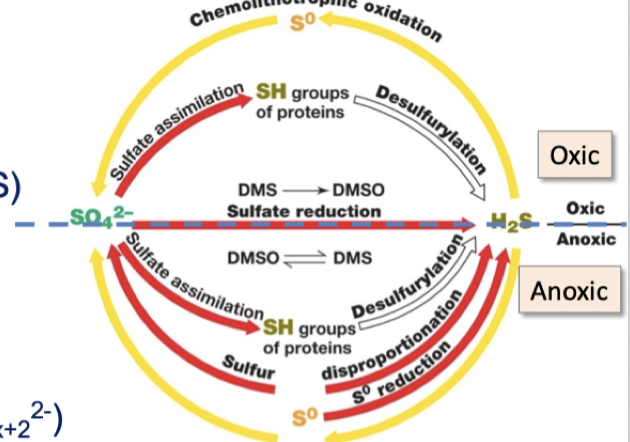
98
New cards
why cycle?
for energy flow
99
New cards
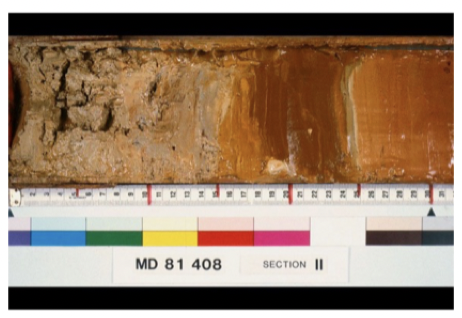
marine sediments and microbial fuel cells
Drilling programes with cores
Different colours due to, different microbial communities as you go deeper into the sediment
Based off oxygen conc, changing terminal electron acceptor e.g. nitrate
M.O on anode and oxidizes waste water, electrons stolen from micro-organisms to generate electricity
Different colours due to, different microbial communities as you go deeper into the sediment
Based off oxygen conc, changing terminal electron acceptor e.g. nitrate
M.O on anode and oxidizes waste water, electrons stolen from micro-organisms to generate electricity
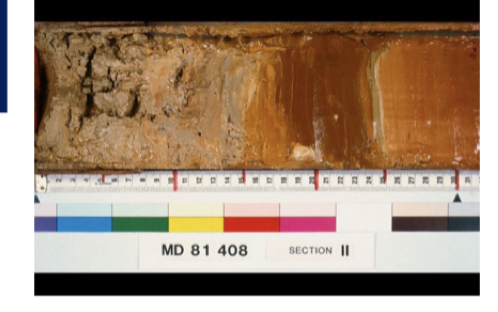
100
New cards
rumen and climate change
Cows
Evolved with methanogens in their system
Cow absorbs organic acids and uses it for energy, also generate H, for electron donor and CO2 for an electron acceptor to make methane
Cow doesn’t need methanogens there
Add a vaccine, wouldn’t produce methane as a waste product
Evolved with methanogens in their system
Cow absorbs organic acids and uses it for energy, also generate H, for electron donor and CO2 for an electron acceptor to make methane
Cow doesn’t need methanogens there
Add a vaccine, wouldn’t produce methane as a waste product